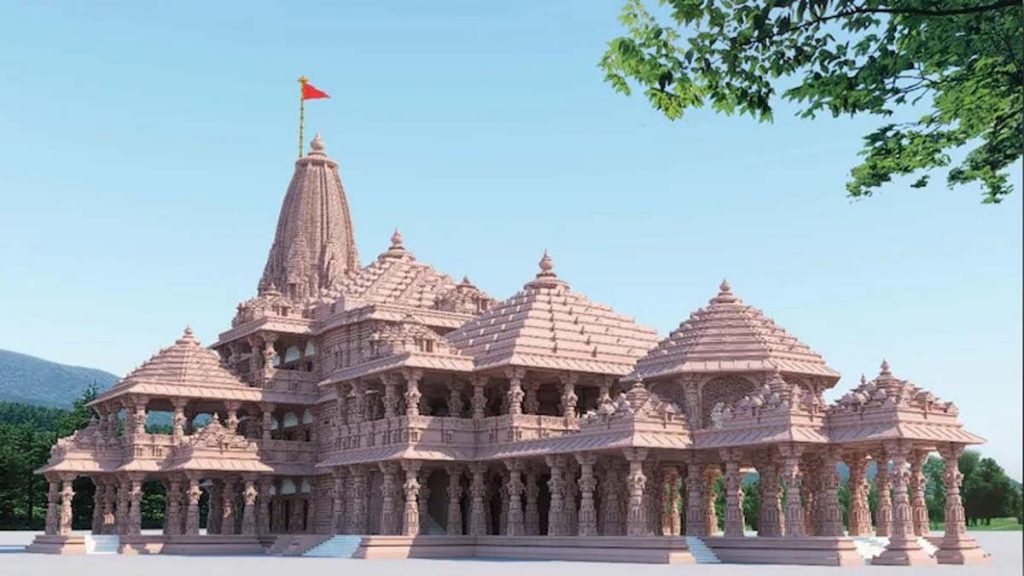On August 5th, 2020 Prime Minister Narendra Damodardas Modi will be attending the Bhoomi Pujan or the commencement ceremony of Ram Janmabhoomi (Temple of Lord Ram’s birthplace). The site, located in Ayodhya, Uttar Pradesh is the birthplace of Lord Ram, the Hindu Avatar of Lord Vishnu and the warrior king hero of the Ramayana epic. Prime Minister Modi will lay the foundation stone for the construction of the mandir (temple) on this day with a 40kg silver brick to be laid at the temple’s core, the sanctum sanctorum. The temple is expected to be completed in 3-3.5 years by 2023.
The mandir is expected to usher in a new age of cultural awakening for the nation of India which has seen itself engulfed in the flames of a degenerative colonial narrative. On December 6, 1992 Karsevaks had destroyed the Babri Mosque sitting atop the birthplace of an earlier temple to Shri Rama built on the site. The first Mughal ruler Babur had ordered his lieutenant Mir Baki to destroy the original temple and place a mosque on its site in 1528. According to the historian, Cunningham, almost 150 000 Hindus led by Hindu King Raja Mahtab died fighting to save the temple against Babur. Lord Ram’s temple was not the only one to be destroyed. Over a long course of 700 years of Islamic rule it is estimated that 40 000 temples, maybe more, are currently lying under mosques including Krishna’s birthplace at Mathura and other sacred sites such as Kashi. Vishwa Hindu Parishad President Alok Kumar commented that the temple’s construction is representative of the country’s fight for its self-respect, culture and ethos, which many conquerors attempted to destroy.
Hindus have waited patiently for 5 centuries for its restoration. The site at Ayodhya remained hotly disputed for the longest while. After 70 years of legal battles since India gained Independence the Supreme Court pronounced the verdict in favor of the mandir on November 9, 2019. Archaeological excavations carried out by the Archaeological Survey of India in 1967-77 and 2003 under BB Lal, KK Mohammed and others yielded the remains of a grand structure, 263 pieces of terracotta gods and goddesses and other sacred architecture (kalasha, amalka, grivah, shikhara) that had all the earmarks of a Hindu temple. In fact 12 pillars from the original temple were reused to construct the Babri mosque. The same was observed at the Quwwatul Mosque near the Qutub Minar which reused pillars of a destroyed temple in its making. In the 2003 excavation 50 pillars were found at the Ayodhya site. In fact, Babri Mosque was known to Muslims as Mosque Janmasthan (Mosque of the birthplace). Other literary evidence shows in the Ain-i-Akbari of Emperor Akbar that Hindus worshipped at the place. The travelogues and diaries of other European travelers to India at the time recorded Hindus worshipping at Ayodhya such as William Filch (1608-1611) and Dutch Geographer Jon Dealeat in 1631 during the time of Emperor Jahangir.
A great temple is currently under construction and will be built according to Vedic principles. Water and soil from thousands of sacred rivers and other places across India, 2578 to be exact, will make their way to sanctify the construction of Lord Ram’s Mandir. These include, Shri Badrinath Dham, Raigad Fort, Shri Ranganathaswamy Mandir,Shri Mahakaleshwar Mandir as well as places connected to many freedom fighters such as Rani of Jhansi and Chhatrapati Shivaji Maharaj will be taken to the Shri Ram Janmabhoomi Teerth Kshetra at Ayodhya Dham. Water from the Ganga and Yamuna River and sacred flowers like the Brahma Kamal growing in the Himalayas will be taken for the foundation stone-laying ceremony. Two brothers Radhey Sham Pandey and Pandit Triphala brought water from 151 rivers and 3 seas they have collected since 1968. The temple is expected to soar to a height of 162-feet and have 5 domes, according to its Chief Architect Chandrakant Sompura.
The Prime Minister of India will be accompanied by many Hindu leaders and around 175 guests who were involved in making the temple a reality including LK Advani, Uma Bharti and Murli Manohar Joshi. In 1991 Modi himself had visited the site and when asked by a journalist if he would return, Modi, the Chief Minister of Gujarat at the time replied, “I will come back when the construction of Ram Mandir will begin.” He has kept his word. The event will be televised across India in keeping with the times.
Hindus across the world are waking up to reclaim their heritage and glory. In the Caribbean most Indo-Caribbean Hindus in Trinidad and Tobago, Guyana and Suriname seem blissfully unaware that Lord Ram’s Temple was even demolished and the history behind its rebuilding. Our Hindu organizations do not seem to have made any great attempt to take anything momentous from the West Indies such as any bricks or sacred soil from our shores and neither have they made much of effort to educate the Hindu population on what is going on despite us having Hindu schools, Hindu radio and Hindu TV stations like Jaagriti. V.S. Naipaul had described the event in his travels, “Pulling down the first emperor’s (masjid) is a marvelous idea. I think in years to come it will be seen as a great moment….It would be a historical statement of India striving to regain her soul.”
Jai Shri Ram
Nisha Ramracha.
